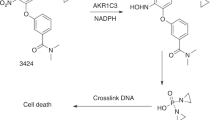Abstract
CI-921, (9-[[2-methoxy-4-[(methylsulfonyl)amino]phenyl]amino]-N,5-dimethyl-4-acridinecarboxamide 2-hydroxyethanesulfonate (1∶1)), an anilinoacridine derivative with activity in experimental solid tumors was studied in a multicenter phase II trial in patients with solid tumors. Eligible tumor types included cancers of the breast, stomach, pancreas, nonsmall cell lung, small cell lung, colon, head and neck area, and melanoma. Prestudy requirements included an ECOG performance status of ≤ 2, no CNS metastases, and measurable disease. CI-921 was administered intravenously over 1–2 hours on days 1,8, and 15 of a 35-day course at an initial dose of 270 mg/M2, with modification in subsequent courses based upon tolerance. Principal toxicities included leukopenia, marked phlebitis, and mild nausea and vomiting. One hundred fifty patients were entered of whom 132 were evaluable for response. There was one complete and one partial response among 19 patients with breast cancer, and two partial responses, one each among 14 head and neck and 36 nonsmall cell lung cancer patients.
Similar content being viewed by others
References
Grove WR, Fortner CL, Wiernik PH: Review of amsacrine, an investigational antineoplastic agent. Clin Pharm 1:320–326, 1982
Grove WR, Delap LW, Grillo-Lopez AJ: CI-921: An analog of amsacrine with experimental activity against solid tumors. Invest New Drugs 4:113–118, 1986
Baguley BC, Denny WA, Atwell GJ, Finlay GJ, Rewcastle GW, Twigden SJ, Wilson WR: Synthesis, antitumor activity, and DNA binding properties of a new derivative of amsacrine, N-5-dimethyl-9-[(2-methoxy-4-methylsulfonylamino) phenylamino]-4-acridinecarboxamide. Cancer Res 44:3245–3251, 1984
Robert F, Mignucci M, Grove WR, Javier J, Asmar S, GrilloLopez AJ: Phase I study of CI-921: Single dose schedule. Proc Am Soc Clin Oncol 6:26, 1987
Grove WR, Grillo-Lopez AJ, Robert F, Harvey V, Leiby J, Javier J, Hardy J, Grever M: Optimizing therapeutic potential of Phase I studies: coordination of three worldwide studies of CI-921. Proc Eur Cong Clin Oncol 4:287, 1987
Hardy JR, Harvey VJ, Paxton J, Evans P, Smith S, Grove WR, Grillo AJ, Baguley BC: Phase I trial of the amsacrine analogue 9-[[2-methoxy-4-[(methylsulfonyl)amino]phenyl]amino]-N,5-dimethyl-4-acridinecarboxamide, (CI-921). Cancer Res 48:6593–6596, 1988
Harvey VJ, Hardy JR, Smith S, Grove W, Baguley BC: Phase II study of the Amsacrine analogue CI-921 (NSC 343499) non-small cell lung cancer. Eur J Cancer 27:1617–1620, 1991
Sklarin N, Wiernik P, Mittelman A, Maroun J, Stewart J, Robert F, Doroshow J, Akman S, Rosen P, Gota C, Jolivet J, Belanger K, DeConti R, Robert N, Velez-Garcia E, Bergsagel D, Panasci L, van der Merwe A, Leiby J, Grove WR, Hawkins E, Kowal C: A Phase II evaluation of CI-921 in patients with solid tumors. Proc Am Soc Clin Oncol 9:285, 1990
Simon R: How large should a Phase II trial of a new drug be? Cancer Treat Rep 71:1079–1085, 1987
Author information
Authors and Affiliations
Rights and permissions
About this article
Cite this article
Sklarin, N.T., Wiernik, P.H., Grove, W.R. et al. A phase II trial of CI-921 in advanced malignancies. Invest New Drugs 10, 309–312 (1992). https://doi.org/10.1007/BF00944186
Issue Date:
DOI: https://doi.org/10.1007/BF00944186




